A Boat Repairman Dies From Burns Received From a Fire Caused by an Exploding Battery.
California Case Report: 07CA004
Summary
A 68-year-old boat repairman died from burns he received from a fire caused by an exploding battery. The victim was connecting a battery charger to a battery when the battery exploded. The explosion started a fire that engulfed a boat and the victim. The victim was not wearing clothing or safety apparel appropriate for the work being done. The victim was alone in the shop at the time of the incident. The company had no documented safety or training programs available for the employees to follow. The CA/FACE investigator determined that, in order to prevent future occurrences, employers should:
- Ensure employees follow documented battery charging guidelines.
- Ensure employee clothing and safety apparel is appropriate for the work being done.
- Establish and maintain an Injury and Illness Prevention Program (IIPP).
- Establish and maintain training and testing programs that verify and document an employee’s achievement of skills.
Introduction
On May 25, 2007, at approximately 7:00 a.m., a 68-year-old boat repairman died from burn injuries he received from a battery explosion and fire. The CA/FACE investigator learned of this incident on May 29, 2007, through a facsimile from the Santa Ana District Office of the Division of Occupational Safety and Health (Cal/OSHA). Contact with the victim’s employer was made on June 4, 2007. On June 7, 2007, the CA/FACE investigator traveled to the company that employed the victim and interviewed the company’s owner and other employees in the shop. Photographs of the incident scene were taken.
The employer of the victim was a small service, maintenance, and sales shop of trailed boats. The company had been in business for over 20 years and had two employees.
The victim had worked for the company for about two and one half years as a private contractor. He only worked when needed. The victim had a key to the shop and came and went as he desired.
The company did not have a safety program or an Injury and Illness Prevention Program (IIPP). The company did not have a training program that provided safety training to employees. The victim was experienced in boat maintenance and repair. According to the company owner, the victim had been a technical representative for a major outboard motor manufacturer in Florida for many years and taught boating safety classes.
Investigation
The site of the incident was a maintenance and service shop for trailed boats. On the day of the incident the victim went to the shop and let himself in with his own key. The victim placed a marine battery on the floor of the shop near a battery charger and a customer’s boat. The victim was attempting to attach a battery charger to a marine battery when the battery exploded. The explosion caught the customer’s boat and the victim on fire. The victim attempted to put the fire out on the boat even though he was on fire himself. Passersby saw the fire and called 911. The paramedics and fire department arrived and treated the victim, then transported him to a local hospital where he died from his injuries.
Cause of Death
The cause of death according to the death certificate was thermal burns.
Recommendations/Discussion
Recommendation #1: Ensure employees follow documented battery charging guidelines.
Discussion: The charging of lead-acid batteries can be hazardous. However, many workers may not see it as hazardous since it is such a common activity in many workplaces. The two primary potential hazards are from hydrogen gas formed when the battery is being charged and the sulfuric acid in the battery fluid. Batteries contain sulfuric acid, which is poisonous, corrosive, and causes burns/irritation on contact with the skin or eyes. Short circuits can cause extensive arcing, burning and melting of metal objects, and explosion of any charging gases. Electric shocks can also be received both from the batteries and from the charging equipment. There is a risk of fire and/or explosion if flammable mixtures of hydrogen with air accumulate. The following safe working practices for charging batteries are designed to prevent similar incidents form occurring:
- Always switch off the battery charger before connecting or disconnecting any battery.
- Always use insulated tools.
- Never place tools or other conductive objects on top of the battery when it is being charged.
- Remove any metallic items from hands, wrists, neck (e.g., rings, chains), which may cause accidental short circuits.
- Always disconnect the negative terminal first and the positive terminal last.
- When charging lead acid batteries, always ensure there is adequate ventilation to dissipate hazardous gasses that vent from the battery when charging.
- Designate the charging area ‘No Smoking.”
- Before connecting charger, always add water to each cell until battery acid covers plates to help purge extra gas from cells. Do not overfill.
- After charging, fill the battery to level specified by battery manufacturer. For a battery without removable caps (maintenance free battery), carefully follow manufacturer’s instructions on charging. (Some sealed maintenance free batteries have a battery condition indicator. A light or bright colored dot indicates low water. Such a battery needs to be replaced, not charged or jump started).
- Charge battery with caps in place. Most U.S. batteries are made with flame arresting caps. Do not pry caps off sealed batteries.
Employers can enhance worker compliance with safe work practices through programs of task specific training, supervision, recognition, and progressive disciplinary measures.
Recommendation #2: Ensure employees clothing and safety apparel is appropriate for the work being done.
Discussion: Most man-made fabrics, such as nylon, acrylic, or polyester, will melt when ignited and produce a hot, sticky, melted substance causing extremely severe burns. When exposed to extreme heat and flames, clothing containing some synthetic materials like polyester will melt and can fuse to the skin. This essentially creates a second skin and can lead to horrific, disfiguring burns. The clothing worn by the victim was made of a polyester material and therefore was inappropriate for the work being performed. Clothing should be of such design, fit, and durability as to provide adequate protection against the hazards for which they are designed. They should be reasonably comfortable and not unduly encumber the employee’s movements. The protection worn by employees when handling or charging batteries should also include safety apparel, such as a face mask, goggles, apron, and gloves. Had the victim been wearing proper clothing and safety apparel for the work being performed, the incident might not have been prevented, but his injuries may not have been fatal.
Recommendation #3: Establish and maintain an Injury and Illness Prevention Program (IIPP).
Discussion: In this particular case, the employer had no safety program in place for the employees to follow. Having a documented safety program and an IIPP has proven to be an effective method of ensuring all employees receive the necessary safety information needed to do their jobs. An effective IIPP should contain the following:
- The name of a person or persons with authority and responsibility for implementing the IIPP.
- A system for ensuring that employees comply with safe and health work practices.
- A system for communicating with employees in a form readily understandable by all affected employees on matters relating to occupational safety and health, including provisions designed to encourage employees to inform the employer of hazards at the worksite without fear of reprisal.
- Procedures for identifying and evaluating workplace hazards, including scheduled periodic inspections to identify unsafe conditions and work practices.
- Procedures to investigate occupational injury or occupational illness.
- Methods and/or procedures for correcting unsafe or unhealthy conditions, work practices, and work procedures in a timely manner based on the severity of the hazard.
- Training and instruction.
Employers having fewer than ten employees are permitted to communicate to and instruct employees orally in general safe work practices, with specific instructions with respect to hazards unique to the employees’ job assignments. Had the employer had a safety program in place, the hazard might have been identified and eliminated before this incident occurred.
Recommendation #4: Establish and maintain training and testing programs that verify and document an employee’s achievement of skills.
Discussion: In this particular case, the employer had no training program in place for the employees to follow. The purpose behind a documented training and testing program is to ensure all employees receive the same safety information and that their achievement of skills is verified before proceeding with any given task. A training and testing program should be given:
- To all new employees.
- To all employees given new job assignments for which training has not previously been received.
- Whenever new substances, processes, procedures, or equipment are introduced to the workplace and represent a new hazard.
- Whenever the employer is made aware of a new or previously unrecognized hazard.
- For supervisors to familiarize themselves with the safety and health hazards to which employees under their immediate direction and control may be exposed.
Reference
- California Code of Regulations
Subchapter 7. General Industry Safety Orders, Group 1. General Physical Conditions and Structures, Article 3. Special Design Requirements, §3203. Injury and Illness Prevention Program, Group 2. Safe Practices and Personal Protection, Article 10. Personal Safety Devices and Safeguards, §3380. Personal Protective Devices. §3383. Body Protection. - California Code of Regulations
Subchapter 5. Electrical Safety Orders, Group 1. Low-Voltage Electrical Safety Orders Article 59 Hazardous (Classified) Locations, §2540.5. Commercial Garages, Repair and Storage. (c) Battery Charging Equipment. - http://www.ccohs.ca/oshanswers/safety_haz/battery-charging.htmlexternal icon
- http://www.devonline.gov.uk/index/information_and_services/environmental_health/eh-healthandsafety-intro/eh-hs-guidance/eh-hs-batterycha.htm (Link no longer available 10/30/2013)
- https://www.osha.gov/pls/oshaweb/owadisp.show_document?p_table=standards&p_id=10742 external icon
- http://www.battery-chargers.com/charging_instructions.htmexternal icon
Exhibits
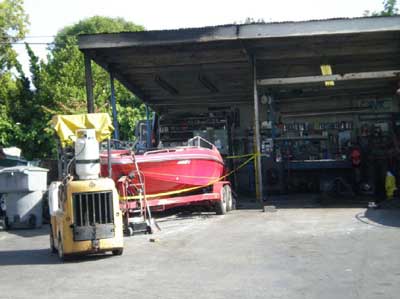
|
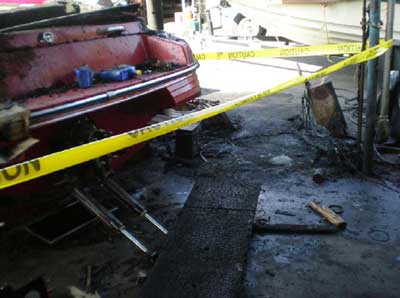
|
|
Exhibit 2. A picture of the area in the shop where the incident occurred.
|
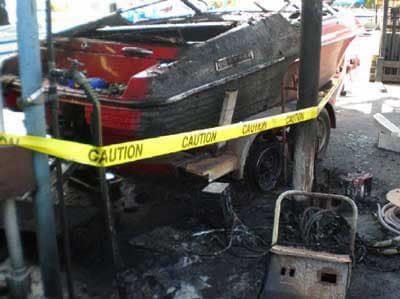 |
|
Exhibit 3. A picture of the boat that caught on fire. |
 |
|
Exhibit 4. A picture of the remains of the clothes the victim was wearing. |
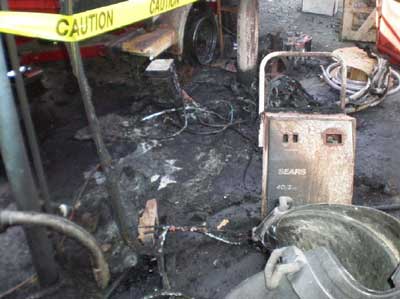 |
|
Exhibit 5. A picture of the battery charger involved in the incident.
|
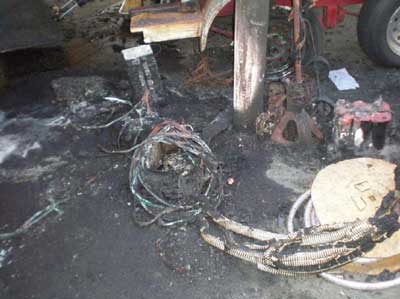 |
|
Exhibit 6. A picture of the battery that blew up. |
California Fatality Assessment and Control Evaluation (FACE) Project
The California Department of Public Health, in cooperation with the Public Health Institute and the National Institute for Occupational Safety and Health (NIOSH), conducts investigations of work-related fatalities. The goal of the CA/FACE program is to prevent fatal work injuries. CA/FACE aims to achieve this goal by studying the work environment, the worker, the task the worker was performing, the tools the worker was using, the energy exchange resulting in fatal injury, and the role of management in controlling how these factors interact. NIOSH-funded, State-based FACE programs include: California, Iowa, Kentucky, Massachusetts, Michigan, New Jersey, New York, Oregon, and Washington.
To contact California State FACE program personnel regarding State-based FACE reports, please use information listed on the Contact Sheet on the NIOSH FACE web site. Please contact In-house FACE program personnel regarding In-house FACE reports and to gain assistance when State-FACE program personnel cannot be reached.
